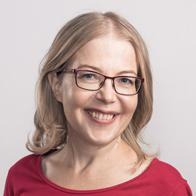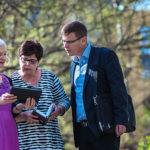
Sari Pohjola
The background of the Competence is the Key project
In the Finnish disability associations, there has been a number of projects in the field of vocational education. However, disability associations and universities have not had many projects with a focus on students in higher education. Higher education would increase the opportunities for disabled students in many areas of life, but their path is not problem-free. At Vamlas, we have often heard that students have difficulties in gaining quality traineeship placements, and finding employment after graduation is very challenging. In response, Vamlas wanted to start a cooperation project with a university, focusing on accessibility, guidance, and transferring to employment. Häme University of Applied Sciences (HAMK) had similar interests.
Vamlas, founded in 1889, promotes the inclusion of children and young people with disabilities in schools, studies, and working life. HAMK has been an active member in the accessibility network of the Finnish universities (ESOK) and wanted to further develop the knowledge of accessibility issues and the guidance skills of the university staff. This was the starting point of our project – Competence is the Key (ORA). The ORA project also developed assistive technology and cooperation with employers, but this article focuses on career guidance and staff training. This article is based on my own reflections during the project, while analysing various university practices from an external point of view.
As a starting point of the ORA project, we used a survey (Yletyinen 2015) which was distributed to the HAMK guidance counsellors. The respondents of the survey said that they needed more information on how to recognise special needs and how to support and provide guidance to students in this group. According to the counsellors, about six percent of HAMK students have special needs. The types of special needs expressed in the survey range from mental health issues and learning difficulties to life management skills and social problems. Very few students in HAMK have physical or sensory disabilities. Due to this, in the project, we mostly talk about “students with special needs” or “students with special educational needs” rather than “students with disabilities”.
Students with disabilities in Finnish universities
The Finnish higher education system comprises fourteen universities and twenty-five universities of applied sciences (UAS). Universities engage in scientific research and based on it, provide the highest level of education. Universities of applied sciences are multidisciplinary and regional higher education institutions, whose activities highlight their connection to working life and regional development. (Ministry of Education 2017.) HAMK operates on seven campuses and has around 7000 students, and 600 teaching and other staff.
Due to data protection laws, Finnish universities do not keep records of students with disabilities. They can only collect information on how many special arrangements have been made for their studies. However, various surveys offer some idea of the figures. According to the Otus Student Barometer 2016 survey, around twenty percent of university students report having disabilities, special needs, or chronic illnesses (18% in universities of applied sciences and 22% in academic universities). Seven percent of respondents have a disability which they feel greatly affects their studies. (Saari 2017.) The ORA project wanted to reach this group of students in particular, but also include the larger group of students who might have challenges in studies and career planning.
Mental health problems are the most common health impairment among Finnish university students. According to the Student Health Survey (Kunttu, Pesonen, & Saari 2016, 89), the proportion of students diagnosed with depression and anxiety disorders has almost tripled since 2000. Only sixty-six percent of students feel their mental health is very good. In this survey, around eight percent of all university students (universities of applied sciences 10.6%, academic universities 6.5%) report having a disability that affects their learning like dyslexia or attention deficit disorder. (Kunttu et al. 2016, 36.)
Commonly, problems only become apparent when a student starts studying in a university. The high pressure of studying increases the risk of mental health problems. At universities, there are compulsory language studies and books in English, and these can be an obstacle for dyslexic students. Autism spectrum disorder may be revealed when a young adult moves away from home, there is a change in routine and previous coping mechanisms fail (Huhtiniemi & Nygren 2016). University teachers are often the first to notice that a student has problems when there are issues with the student’s progress.
Accessibility according to students
In the Accessibility in Higher Education survey, students reported their experiences of the various areas of accessibility in their own educational institutions. About half of the respondents did not know whom to turn to for questions of accessibility. According to the survey, support is most needed in flexible and individual planning of studies, personal guidance, availability of staff, comprehensive wellbeing, and in procedures for and handling accessibility issues. (Villa & Kivisalmi 2016, 62.) Forty-two percent of respondents were considered to belong in a “special group”. In this survey, a “special group” refers to students with mental health issues, sexual minorities, students with challenging life circumstances (i.e. working full time, single parents), students with chronic illnesses and disabilities (physical, sensory, neurocognitive), language minorities, older students (ibid., 11). Students in this group were less satisfied with the various areas of accessibility and inclusion in student life in general, including student admissions, information, and support services, practical training arrangements, student associations, communications, and physical facilities (ibid, 5).
Experiences of the ORA project
According to the HAMK strategy, all teachers and staff provide guidance to students. The ORA project adopted this approach, as well. However, guidance and support personnel were more active participants in project events and training than teachers.
Educating and training university staff
One of the key targets in the ORA project was to bring the experience and knowledge of disability organisations to the university. This way, we answered the need to raise information mentioned in the HAMK guidance counsellor survey (Yletyinen 2015). Counsellors wanted to know how to recognise various special needs and how to best support the student. Education and training was organised on topics the counsellors felt were most needed. For instance, the Autism Foundation provided training on the autism spectrum condition and how to best deliver guidance to an autistic student. We also organised staff training on mental health and dyslexia.
People with disabilities, “experts by experience”, presented their views during various training sessions and seminars organised by the ORA project. Using “experts by experience” and other specialists from disability organisations is a good practise to adapt to future training sessions. The participants felt their expertise was very valuable for the training, as they bring practical ideas and a new viewpoint to the topic.
Career workshops
One of the goals of the project was to increase the number of the students’ opportunities of career guidance. The project ran career workshops for students during four semesters. The workshops were open to all students and were held both in the classroom and a virtual study environment to increase the possibility of participation from different campuses. In addition to the workshops, the career coach of the project provided individual guidance to students.
The goal of the workshops for the students was to learn to recognise their skills and strengths and market themselves to the employer. Students analysed their skills gained in different areas of life. We practiced job interviews and application writing and prepared LinkedIn and video CV. After the project, career workshops will be adopted as part of voluntary studies offered in HAMK, albeit on a smaller scale. This is an important achievement for the project.
One challenge we faced was finding our target group. Finnish universities do not keep a register of students with special needs and disabilities. We wanted them to attend career workshops, but in order to avoid labelling participants, we did not wish to have emphasis on the workshops being aimed especially for students with disabilities in the marketing. The workshops were open to all students who needed help in career planning, because it would be against the principle of inclusion to offer education and training solely for students with special needs and disabilities. Also, we cannot presume they all need career guidance. However, with the help of guidance counsellors, we managed to reach some students from the project target group. In the individual guidance sessions, the proportion of our target group was even higher.
Another major challenge was engaging local employers in the project and finding the right message. In this area, we would have needed higher commitment from the staff in various departments. We reached out to the employers in various recruitment and networking events, and some employers talked about their experiences in our seminars.
Questions we faced in the project
Does the staff recognise students’ special needs?
In primary education, students with special needs have various support services. However, at universities, the issue of special needs almost disappears. When asking university teachers whether they have students with disabilities or special needs, the answer is usually “very few” or “I don’t know”. This is partly because “special needs” is not a concept used at universities, and partly because the staff is not able to recognise these students. Invisible disabilities and special needs, in particular, are problematic. When recognised, they might be ignored; a teacher might say “Aren’t the university students supposed to be independent? If they can’t cope with the pressures of studying, maybe the university is not the right place for them”. In HAMK, the policy is that all teachers provide guidance and individualised support, but there is still a lot to improve. A lack of resources, guidance skills or knowledge are still major issues. Guidance counsellors, study psychologists, student health care professionals, and curators deal with various special needs in their daily work. The questions they often have are “how far should we go in supporting a student?” and “where to find help?”
The university staff wants the students to complete their studies because graduation brings money to the university. Finnish universities also receive part of their budget based on the graduates’ success in gaining relevant employment. Thus, there are policy factors pushing towards providing individual and effective support to all students.
How do we best provide support without too much labeling?
The Finnish universities accessibility network (ESOK) advocates inclusive education which takes into account individual needs and learning styles, but does not focus too much on diagnoses. ESOK is a loose network of staff interested in accessibility issues in Finnish universities. It was created to continue the work of the ESF project (2006–2011).
In HAMK, a student who needs special arrangements for her studies needs good grounds but not always a diagnosis. Special arrangements have to be approved by a student welfare specialist. Once it is approved, a student can receive a pass she can show to teachers. While carrying the pass, she does not have to explain her reasons. Sometimes, the problem is that the teacher can see that a student would benefit from extra time in an exam, having a discussion with a psychologist, etc., but the student does not recognise the need and wants to continue as usual. It is also a question of enclosure, which can be difficult, if the general atmosphere is not encouraging towards expressing special educational needs.
On the other hand, special arrangements are not always needed. There are various study methods in a university, and the teacher can select the one suiting the student best. Diverse options for completing courses is also something students wished for in the Accessibility in Higher Education survey (Villa & Kivisalmi 2016, 62). Instead of special needs, maybe we should instead talk about the individual needs of every student.
Do we need special arrangements to promote employment?
Special arrangements exist for studies, but should we also have them to gain traineeships? At universities of applied sciences, traineeships are a central part of all study programs. Due to the high demand of traineeship placements, they are not easy to find in all study fields. Students with disabilities or special needs often face difficulties in finding external placements and can end up doing all their traineeships in the university workshops, etc. Some type of extra support would be useful for them.
Academic universities receive annual funding from the Finnish Ministry of Education and Culture to finance student traineeships. Universities can create their own policies to determine how the money is shared among students. Usually, the employer is expected to pay most of the student’s traineeship salary, and the university pays the rest from the traineeship fund. However, there is not enough money to support all students, and many study programs do not even have compulsory traineeships. A case for positive discrimination could be that students with disabilities are given a bigger share of traineeship money. However, this solution would doubtfully receive much support.
The general ethos in Finland is that everyone is entitled to the same; we should not elevate somebody to have more than others. Finns also believe a person should be independent and self-reliant from early on. In this context, it is often forgotten that equality does not mean giving the same to everyone, but giving to everyone according to their needs, so that they can have equal possibilities. Furthermore, in certain circumstances, our legal system also allows positive discrimination.
More attention needed for accessibility and career guidance
The ORA project has not provided answers to all the previously mentioned questions, but even asking the questions is a step forward. Some recommendations can be made based on the experiences of the project.
Accessibility Advisor enables better services
Students need to know whom to turn to with their questions of accessibility. In the project, we heard of cases when a student presented an accessibility problem to a staff member, but nothing happened, as it “fell between the chairs”, so nobody took responsibility for it.
In most Finnish universities, accessibility-related tasks are shared between various staff members. It is difficult to locate the right person on the website, especially from outside the university. It would be a good practice for every university to have a named Accessibility Advisor, who coordinates issues related to accessibility. The ESOK network has been promoting this idea, as well. In Finland, only three universities have a full-time Accessibility Advisor, and their responsibilities are varied.
The existence of a full-time Accessibility Advisor would allow for better resources to handle a wide variety of accessibility questions. It sends a message that a university is taking accessibility issues seriously and would encourage prospective applicants with disabilities to apply. An Accessibility Advisor can evaluate accessibility in all areas of university life and support the teachers with questions, considering that accessibility is important not only for studying but also for guidance, communications, administration, facility management, and the strategy of the university. A full-time Accessibility Advisor can also be more involved in projects and other external cooperation with universities, disability associations, and public bodies.
Everyone needs quality career guidance
According to the Student Health Survey (Kunttu et al. 2016, 75), university students are happier with the study guidance and counselling services than before. Only 6.8 percent are very unsatisfied compared to 16.5 percent in 2004. This positive trend in study guidance should be extended to career guidance, as well. In the HAMK 2013–2014 graduate career survey, the respondents proposed the study programs to include more career management skills and general working life skills (Kuisma 2016). Gaining and recognising relevant skills and planning one’s career is important for everyone in the constantly changing world of employment, even more so for students with special needs.
Academic universities have centralised career services, which support university departments, staff, and students on issues related to employment. All universities of applied sciences have guidance counsellors but a centralised careers service or a career advisor are rare. Guidance counsellors focus on guiding the students through their studies, so there is less emphasis on job hunting skills, etc. In HAMK, the responsibility of career guidance is shared between the guidance counsellors and teachers. Teachers prepare students for traineeship periods, receive traineeship feedback, and cooperate with employers. However, both teachers and guidance counsellors have expressed a need for more knowledge of career guidance methods (Lundahl 2017). Alumni are also an underused resource in preparing students to working life.
During the project, we expressed the concern that students are not receiving enough career guidance. Additionally, the quality and content of career advice students receive depends on the UAS department and its staff, their skills, resources, and interest. Preparation for working life and career guidance are embedded in all the UAS study programs and methods. However, when it is embedded, it easily becomes an abstract concept not visible to students. Students who are insecure about their choices or who have special needs would especially benefit from concrete, “hands on” support on how to analyse their skills, how to look for work, what options they have in working life, etc. The lack of student motivation and discontinuing studies is a problem, particularly at universities of applied sciences. Could quality career guidance, a clearer idea of future work opportunities help with motivational issues, too? According to Kuurila (2014, 130) it is very much so.
Students should also be told directly about the kind of competences they are expected to gain from various courses. In the project, career workshop participants found it particularly eye-opening to go through the learning targets set for various courses and reflect on the skills they have gained. They had not seen the learning targets or taken the time to go through them before.
In the ORA project, we wanted to raise the importance and visibility of career guidance. As a result, it is now written into the guidance model used in HAMK. The career workshops we started will continue as voluntary studies. Providing career workshops and career guidance sends an important message to the students. It says “we don’t just care about your graduation, we care where you go from here”.
Author

Sari Pohjola is a Communications Coordinator in Vamlas, foundation supporting children and youth with disabilities. Previously, she worked in CIMO (nowadays Finnish National Agency for Education) promoting international cooperation in the field of guidance, and Careers Services in Helsinki and Turku universities.
References
Huhtiniemi, M. & Nygren, I. (2016). Autismin kirjo, erityispiirteet ja niiden vaikutukset opiskeluun ja työhön. Training for guidance counsellors by Autism Foundation 2nd February 2016, Häme University of Applied Sciences.
Lundahl, A. (2017). Uraohjauksen tueksi. Development project. Vocational guidance counsellor training, Häme University of Applied Sciences.
Kuisma, P. (2016). Valmistuneiden sijoittumisseuranta HAMKissa – trendit ja muutokset 2008–2014.
Presentation in Amkista Uralle project kick-off event, 7 April 2016, Häme University of Applied Sciences.
Kunttu, K., Pesonen, T., & Saari, J. (2016). Finnish Student Health Survey. Finnish Student Health Service research report Nr. 48. Arkmedia Oy. Retrieved 10 April 2018 from http://www.yths.fi/filebank/4310-KOTT_englanti_2016.pdf
Kuurila, E. (2014). Uraohjaus ja urasuunnittelu ammattikorkeakoulussa. Academic dissertation. Turun yliopiston julkaisuja Sarja C-osa. Turku: Scripta Lingua Fennica Edita. Retrieved 10 April 2018 from http://urn.fi/URN:ISBN:978-951-29-5771-2
Ministry of Education and Culture (2018). Higher education institutions, science agencies, research institutes and other public research organizations. Retrieved 4 April 2018 from http://minedu.fi/en/heis-and-science-agencies
Saari, J. (2017). Katsauksia ajankohtaisiin Otuksen tutkimuksiin opiskelun saavutettavuudesta. Presentation in the seminar ”Siltoja Saavutettavuuteen”, 4 April 2017, Verkatehdas, Hämeenlinna. Retrieved 18 June 2018 from http://www.hamk.fi/tyoelamalle/hankkeet/osaaminen-ratkaisee/tapahtumat/PublishingImages/Sivut/default/Esitys_Juhani%20Saari.pdf
Villa, T. & Kivisalmi, S. (2016). Korkeakoulujen saavutettavuus. Accessibility in Higher Education Survey. Opiskelun ja koulutuksen tutkimussäätiö Otus 53/2016. Retrieved 10 April 2018 from https://drive.google.com/file/d/0B9L1fvjudy3GOU01dE43UjRJSGM/view
Yletyinen, H. (2015) Opiskelijoiden haasteet ja erityisen tuen tarve Hämeen ammattikorkeakoulussa. Development project. Special education teacher training. Häme University of Applied Sciences.





